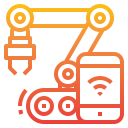Integrating AI With IoT for Smart Homes: Living Spaces That Learn
Chosen theme: Integrating AI With IoT for Smart Homes. Welcome! Step into a home that understands you—anticipating needs, saving energy, and keeping loved ones safe. Read on, share your thoughts, and subscribe for fresh, hands-on inspirations every week.


How AI Supercharges Your IoT Home
Your home brims with signals—temperatures, motion, light levels, door states, even power draw. AI turns those raw readings into meaning: presence, intentions, comfort, and risk. When devices speak context instead of numbers, automations feel natural. What devices would you connect first? Tell us below.
How AI Supercharges Your IoT Home
AI observes patterns—weekday wake-ups, movie nights, weekend chores—and proposes gentle automations you can approve. On-device learning and scheduled training windows protect privacy while improving accuracy. Aisha shared that her home learned quiet pre-dawn coffee prep, sparing clattering lights. Would you allow that? Comment your comfort level.

AI blends weather forecasts, occupancy insights, and tariff schedules to preheat or precool only when it matters. The Rivera family reported an eighteen percent reduction over three months after enabling predictive heating. Curious what you might save? Subscribe for our calculator and share your baseline usage.

Circadian lighting that warms at dusk, soundscapes that hush traffic rumble, and fans that nudge airflow exactly when rooms feel stuffy—AI coordinates it quietly. Guests notice comfort, not gadgets. What scene defines your ideal evening? Drop a comment and we may feature your setup.

On-device person detection flags visitors without streaming your living room to the cloud. If an entry opens at odd hours, lights up and your phone pings, but footage stays local unless you choose otherwise. Would you enable package detection on your porch? Tell us how you’d tune alerts.
Data, Privacy, and Trust by Design
Data minimization is powerful: summarize motion to “likely occupied” rather than saving every step. Compress camera frames into privacy-preserving embeddings instead of storing faces. Keep raw data local whenever possible. Does this match your values? Share your red lines for an AI‑powered home.
Data, Privacy, and Trust by Design
A good system shows what was sensed, why an action fired, and how to undo or refine it. Audit logs demystify automations, building confidence over time. We’re drafting a starter template—subscribe to get it early and help us refine the most helpful privacy indicators.
Data, Privacy, and Trust by Design
Households aren’t single users. Set room-level permissions, guest modes, and teen-friendly limits. Let roommates approve routines that affect shared spaces. Pause microphones during dinner; allow doorbell inference only in the daytime. What household role are you designing for first? Comment and compare approaches.
Edge vs Cloud: Finding the Right Balance
Doorbells, locks, and lights want instant responses—run those models locally. Big-picture insights like seasonal energy tuning can live in the cloud. Balance subscription costs, bandwidth caps, and comfort with offsite data. Where do you draw the line? Share your threshold in the comments.
Edge vs Cloud: Finding the Right Balance
Plan for outages. Caching schedules, local voice fallbacks, and battery-backed hubs keep core routines alive. Maya’s 1920s bungalow kept lights and heating scenes running through a storm because her AI ran on a tiny edge server. What would your offline essentials be?


Your First 30 Days: A Practical Roadmap

Define outcomes: comfort, savings, safety, or accessibility. Map rooms, note outlets and weak Wi‑Fi spots. Update firmware, name devices clearly, and document your baseline energy use. Comment your goals, and we’ll share matching starter automations tailored to similar homes.
